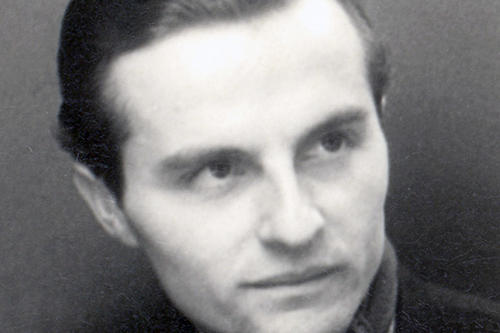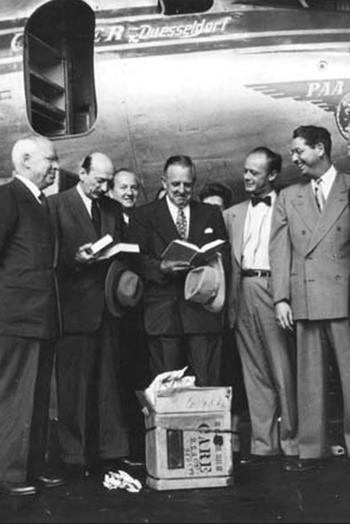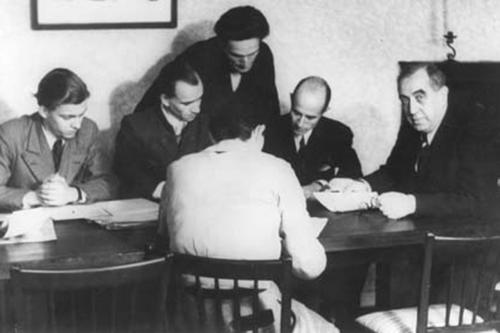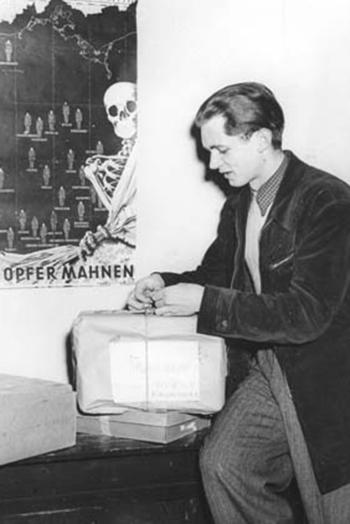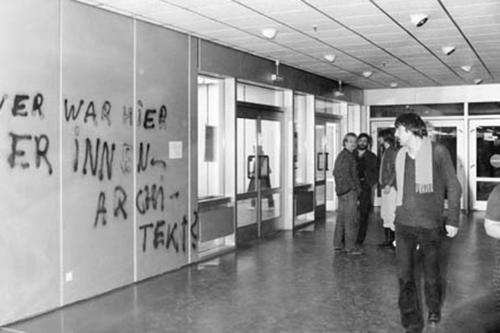The University and Democracy
From the very beginning Freie Universität has seen itself as a university at the heart of democracy.
Karol Kubicki, the first student to enroll at Freie Universität (his enrollment number: 1)
Image Credit: N.N. / Universitätsarchiv der Freien Universität, Fotosammlung
In making student participation an integral part of its independent academic administration, it became Germany's first "reform university." From serving one half of a divided city to serving Germany's capital: the university's development has gone hand-in-hand with that of the East-West conflict. From the material insecurity of the post-war years and the period of reconstruction, right through to the student unrest in the late 1960s, it has always been a place where the fundamental political questions about the future of society and higher education are addressed.
Freie Universität was founded in 1948, mainly on the initiative of students who were committed to freedom and democracy after their bitter experiences under National Socialist dictatorship and who objected to Berlin University, on Unter den Linden, being brought into line with Marxist-Leninist dogma. Thanks to the support of West Germany and the United States of America, Freie Universität was able to flourish as a university of international standing. Members of the intellectual and scientific community came to Dahlem as guests and friends, as they still do, from many parts of the world.
After German reunification, the university was faced with a completely new situation. The Higher Education Structural Plan of the Land of Berlin in the 1990s involved spending cuts of one thousand million DM. Freie Universität has sought to combine the inevitable downsizing with increased emphasis on performance in teaching and research and the development of forward-looking, internationally-competitive centers of academic excellence and co-operative ventures.
A look at the various phases of the history of Freie Universität shows the strong links with the political history of the divided and reunited city of Berlin.
The Founding of Freie Universität
The former Friedrich Wilhelm University was re-opened in June 1946 as the University of Berlin. It came under the Central Administration for Popular Education in the Soviet-occupied zone and thus became a mere subordinate department with no academic administrative autonomy. In the following two years, many students and some teachers, who were opposed to the way university education was becoming molded by Communist ideas, came into conflict with the occupying Soviet power and the SED. Some of the students' representatives were arrested and put on trial.
In April 1948, the expulsion from the university of three students, Otto Stolz (a member of the SPD), Otto Hess (SPD), and Joachim Schwarz (CDU) for publishing critical squibs in the student magazine Colloquium, sparked off a wave of protest. Otto Stolz, speaking at a rally in front of 2,000 students, demanded the foundation of a free university in the Western Sectors of Berlin. Teaching at Freie Universität in the district of Dahlem began in the 1948-49 winter semester with 491 female and 1,649 male students.
First Years
Paul G. Hoffmann, president of the Ford Foundation, handing over the first delivery of 20,000 books that the American Brotherhood was to collect for Freie Universiät to Freiherr von Kreß, the president of Freie Universiät, at Tempelhof Airport.
Image Credit: Remus © Tagesspiegel Freie Universität Berlin, Universitätsarchiv
The shortages of material at Freie Universität during the winter of the airlift in 1948-49 were, like everywhere else in West Berlin, catastrophic. Completely new infrastructure was needed. Those institutes of the former Friedrich Wilhelm University that were situated in Dahlem and the buildings of the former Kaiser Wilhelm Society, which were made available by the Max Planck Society, did not have enough room. Nonetheless, with initiative and a great deal of skill at improvisation, the teachers and students were able to get academic life going. Donations of furniture and books were brought to Dahlem from all over the city, sometimes even on handcarts.
The founding proclamation of Freie Universität promised that every student there would be able to develop her or his own personality freely and unencumbered by propaganda, and that every teacher would be able to teach and do research without having to follow a party-political doctrine. Student brotherhoods of the traditional sort were not, however, permitted at Freie Universität because of their anti-Semitic past. For the first time, students had an official role, with seats and votes, in the independent academic administration of a German university. This "Berlin Model" made Freie Universität the first "reform university" in Germany.
From Stopgap Solution to Established Institution
Meeting of the chairperson of the board of trustees of Freie Universität, Lord Mayor Ernst Reuter, with the curator, F. Bergmann, and members of the student council, D. Spangenberg, G. Grinke, D. Knust, and H. Coper.
Image Credit: Freie Universität Berlin, Universitätsarchiv
In the 1950s, Freie Universität developed into a university with an international reputation. Top names were appointed as professors, many of them returning after having fled from the Nazis, and numerous new institutes were created.
This expansion was financed by funds from the budgets of Berlin and the German Federal Government, and with grants from the United States. By 1967, Freie Universität had received 79.5 million DM in all from U.S. State Department funds and 16.6 million DM from the Henry Ford Foundation. This money was primarily used for a number of new buildings (the Henry Ford Building, the University Library, and the mensa /dining hall) and to found institutes, such as the Institute of Eastern European Studies. In addition, the tutor system, previously unknown in German universities, was introduced, and prominent academics were invited to hold guest lectures.
Within the very first year, the number of students rose from 2,140 to 4,946. About half of these came from West Berlin and a third from East Berlin or East Germany (GDR), with the rest coming from West Germany (BRD) and abroad. For the winter semester 1961-6212, 843 students enrolled at Freie Universität. They took a committed political stand in the 1950s and early 1960s against the influence of former National Socialists in state posts and in society, and also against the Communist dictatorship in the GDR.
Freie Universität in the East-West Conflict
A student preparing food parcels for sending to students in the “East Zone.” In the background is a propaganda poster for the “Liberation Committee for the Victims of Totalitarian Tyranny,” 1952.
Image Credit: Klaus Lehnartz / Landesarchiv Berlin
Students from East Berlin and the region around Berlin were part of life at Freie Universität from the very beginning. Special collections of textbooks and clothing were organized for "Eastern Students," and grant funds were set up. For a time, students from the Soviet occupation zone were even able to exchange its weak currency for Deutschmarks at a rate of one-to-one. In spite of massive propaganda attacks by the Socialist Unity Party (SED) on the "West Berlin NATO University" and its "reactionary political character," the Dahlem campus was an attractive place for young citizens of the GDR to study.
This came to a dramatic halt on August 13th, 1961, when the building of the Berlin Wall cut these students off from their place of learning. Hundreds of their fellow students from the Western part of the city were involved in attempts to help them to escape in the years after the Berlin Wall was built. Many of them were betrayed by informants of the GDR's State Security Service. The SED ensured that they were sentenced to heavy prison sentences.
When government policy shifted toward easing tensions between East and West, Freie Universität took the opportunity to forge relations with Eastern European universities. As early as 1968, it formed a partnership with what was then the Shdanov University in Leningrad.
Protest Years
From the mid-1960s onward, student protest movements grew up in the U.S.A. and Western Europe, including at Freie Universität. In June 1966 the first "sit-in" in a German university took place here when more than 3,000 students from Freie Universität protested in the Henry Ford Building against the planned compulsory deregistration of long-term students in the law and medicine departments of Freie Universität. After ten hours of discussion, the assembly passed a resolution demanding the dismantling of oligarchic rule and the implementation of democratic freedom in all areas of society. Forms of protest adopted from the American Civil Rights Movement, such as "sit-ins" and "teach-ins," soon became part of daily life at West German universities.
On June 2, 1967, Benno Ohnesorg, a student at Freie Universität, was shot and killed by a Berlin policeman during a demonstration against the visit of the Shah of Persia, Reza Pahlavi. In the following months, Freie Universität became a center of the "anti-authoritarian student movement." At first this movement's criticisms of the "Establishment" were rather vague, but they hardened in 1968 with the formation of the "Extra-parliamentary Opposition" (APO) into a fundamental rejection of the existing social system.
The 1970s and 1980s
Corridors and lobbies of the university served as a forum for expression and debate, ca.1977.
Image Credit: Reinhard Friedrich / Freie Universität Berlin, Universitätsarchiv
After the attempt to assassinate Rudi Dutschke, the Extra-Parliamentary Opposition disintegrated into a great number of mutually hostile factions. Activist splinter groups (such as the Red Cells and the K Groups), whose aim was the revolutionary overthrow of the political system in the Federal Republic of Germany, found many supporters at Freie Universität. Strikes, campaigns against individual professors, and skirmishes with police units deployed in several institutes to ensure the continuation of teaching now characterized the public face of Freie Universität. A commonality of teachers and students no longer existed.
During the late 1970s, the number of students tripled and Freie Universität became a mass university. The "Radicals Decree" and the deterioration of conditions for studying sparked off frequent student protests. In spite of the difficult state of affairs and over-regulation of university education by the State, Freie Universität went through a phase of consolidation in the early 1980s. The critical situation caused by years of underfinancing led in 1988 and 1989 to student protests lasting several weeks.
Further Information
This text was composed by Dr. Jochen Staadt and published as part of the permanent exhibition “Future from the Very Beginning” in the Henry Ford Building of Freie Universität. The exhibition highlights the university’s rich and varied history, from its founding in 1948 right up to the present day.

